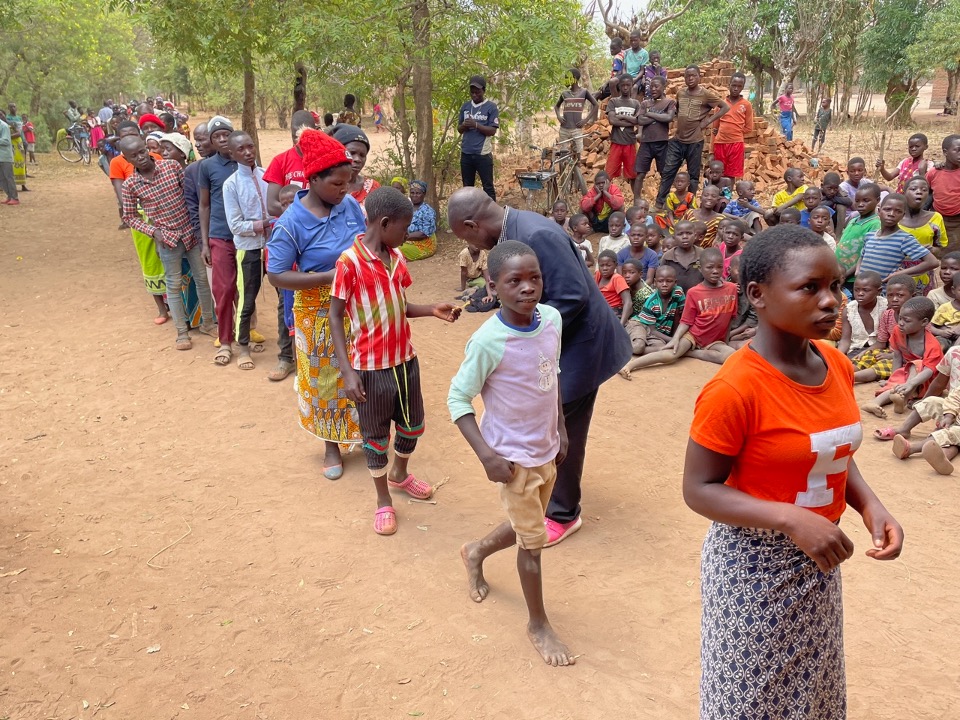
Kayembe Village, Malawi … As the food crisis increases nationwide, here on the front line in Kayembe Village, the situation is evident in the faces of both young and old. Drawn lines, sunken cheeks, and hidden smiles indicate the suffering that comes with the lack of food. The long lines speak for themselves. First to come are the small ones, the orphans, and children whose households have little or no food. There is no pushing, shoving, or crowding to get to the food truck, just quiet well-behaved children waiting for something to eat.
As the lines snake their way to the big truck hundreds of children are given packets of food. Next come the lines of widows and the elderly, someone’s mother another person’s grandmother. The lines keep coming and eventually the old men, fathers, and grandfathers, make their way slowly to the truck. Five bags of food, enough for another month, enough to sustain their lives for a time.
Weight loss, lack of strength, and a blank expression can be seen in many who step forward for the food packets. It is obvious that what little food they could gather was long gone, much of it probably given to babies and small children who are suffering acutely from the shortage.
But what does the future hold for this tiny cluster of humanity trying to survive in a massive sea of need? Planting is just beginning, and harvest is a season away. The need exists in so many parts of the world. There is a warning flag flying and it does not indicate promising times in coming months.
Red Flag Flying
Lilongwe, Malawi … Looking beyond Kayembe Village, and beyond the present, the future appears more serious than even the present. Here are bullet points that reflect what appears to be coming.
- In August 2022 the European Commission reported 2.6 million or 13% of the population of Malawi were experiencing acute food shortages. (IPC Chronic Food Insecurity Report)
- Projections indicated between October 2022 and March 2023 the situation will get worse, with 3.8 million people or 20% of the entire population facing high levels of food insecurity.
- Several uncontrollable factors were highlighted as major contributors to the critical shortfall. These include a harvest shortfall during the present year of an estimated 25 to 35% below average harvest of maize. This was caused in part by low rainfall in some areas of the southern region, while disastrous flooding from tropical storm Ana ravished other locations.
- Low access to fertilizer by smallholder farms in the rural areas affected crop production in several areas.
- Other factors include the price of maize seed. In May 2022 maize prices were running higher than the previous year by an estimated 31 to 214 percent, and 47 to 207 percent higher than the five-year average.
- The war in Ukraine, as well as supply shortfalls are currently pricing many farm families out of the market just as they need to be planting crops for next year’s production.
- Low stocks of food from the previous year, usually held in family storage facilities, have contributed to the shortfall. This is causing many to turn to the national marketplace for food much earlier than in previous years. In turn this contributes to the overall shortage of food.
- The devaluation of the currency by 25% in March 2022 has compounded the problem.
- Add to these indicators the fact that, even though shortages have been growing, there has been little humanitarian assistance going to the population in crisis.
Though Action for Progress and their close working relationships with community farm groups, the food shortages were seen well ahead of many of the indicators being watched by other groups. The Malawi Project and Action for Progress are already distributing food as well as appealing to contributors to help offset the food needs.
